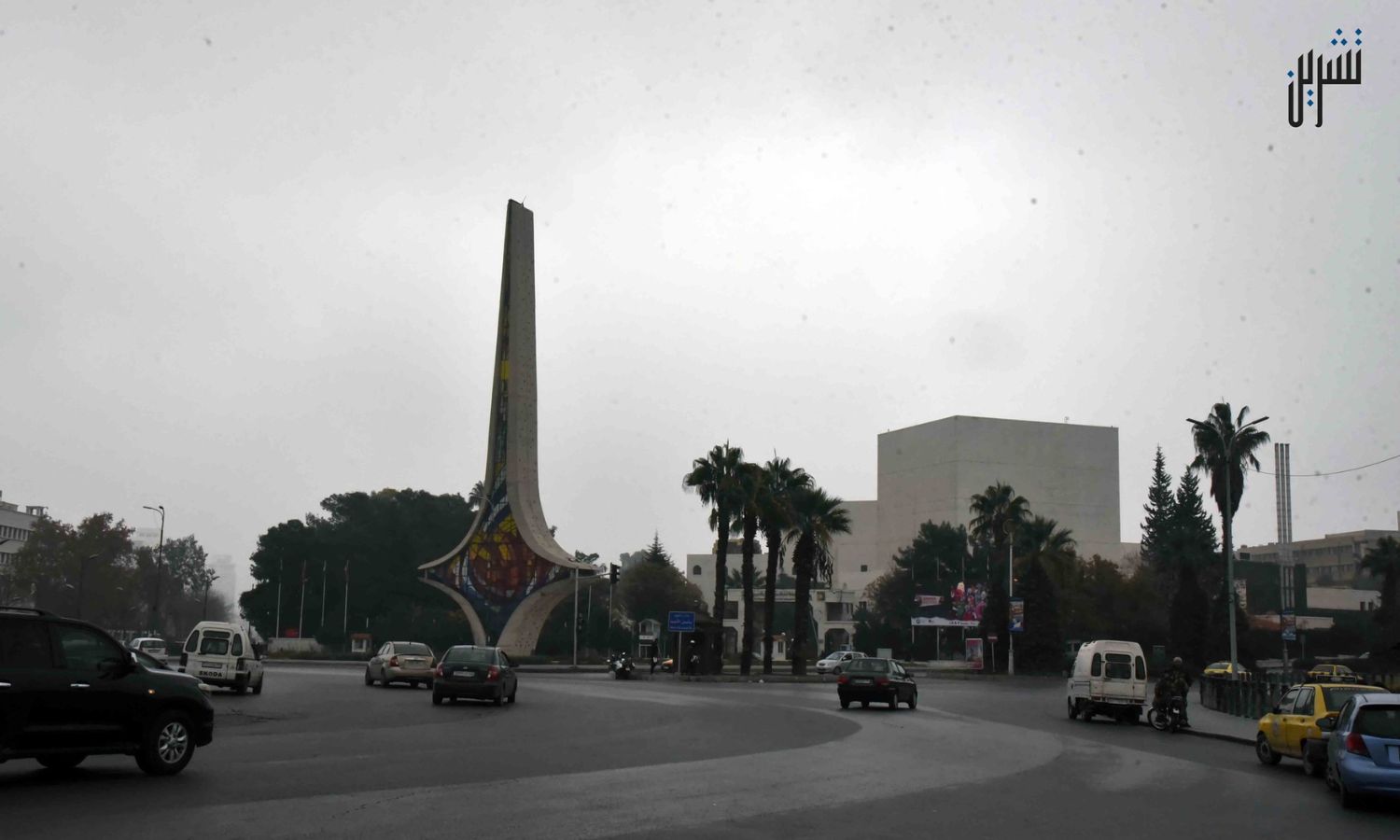


The Umayyad Square in the capital, Damascus, is empty due to the fuel crisis - 14 December 2022 (Tishreen newspaper)


Hassan Ibrahim | Jana al-Issa | Diya Assi | Khaled al-Jeratli
For more than two months, the fuel crisis has afflicted vital Syrian sectors, which has affected the lives of Syrians and cast a shadow over the areas controlled by the Syrian regime. It has also stopped institutions and activities in various fields from operating throughout the country.
Despite the support the regime receives from its allies Russia and Iran and the ability of the two countries to provide it with energy sources, the crisis has not ended, which happened over the years, as these two allies provided economic, military, and political support that contributed to the revival of the Syrian regime.
It is not the first of its kind, but it is the “worst” crisis, according to estimations of experts and researchers, as there are no signs of relief from the crisis on the horizon.
Day after day, the crisis is worsening, despite government justifications for the lack of oil supplies and promises that are not based on clarifications and linking its end to the “cooperation of friends.”
In this file, Enab Baladi discusses with economists, researchers, and analysts the nature and causes of the fuel crisis, the Russian and Iranian role, and the future of the energy sector in light of the Syrian regime’s efforts to obtain the support of allies.
The crisis was accompanied by a decrease in fuel allocations delivered to means of transportation, which created a new transportation crisis in many large governorates, in addition to an increase in electrical “rationing” hours, which in some areas of Damascus reached half an hour of power for 23.5 hours of outage.
The government has taken several decisions related to suspending workers for public agencies on Sundays of the past December, and the entire last week of it, in addition to stopping schools and universities working within the “open learning” system.
The telecommunications sector was also affected by the lack of fuel, as the Syrian Telecom Company announced that a number of its phone centers had gone out of service due to the “difficulty” in securing the fuel needed to operate the electric generators necessary to ensure the continuity of operation of these centers during periods of “rationalization” of electricity. Sports activities have also stopped due to the difficulty of moving club teams due to the lack of fuel and gasoline.
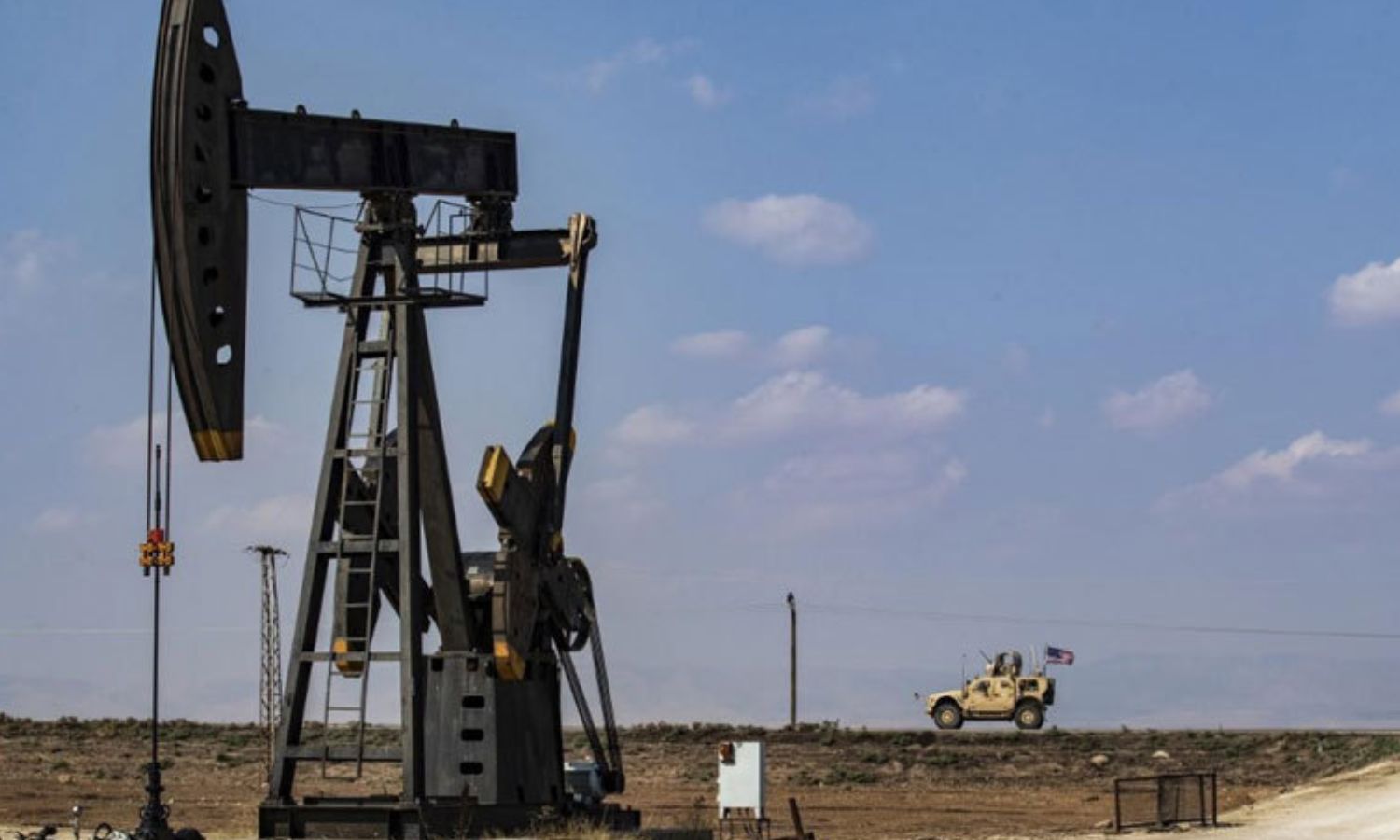
An American military vehicle passes near an oil rig in the countryside of the city of Qamishli, northeastern Syria – 26 October 2019 (AFP)
Since the crisis began, many considered it “fabricated” in a scenario that the regime had previously repeated, with the aim of raising fuel prices under the pretext of “ensuring its availability.” This is what actually happened, as fuel prices of all kinds were raised, but they have not reached the citizens yet.
Raising prices and the lack of availability of fuel also prompted the black market to double its prices, as the price of a liter of gasoline in the governorates of Damascus and Rif Dimashq reached 15,000 Syrian pounds, and in some governorates such as Quneitra and Homs it reached about 18,000 pounds, and the price of a liter of diesel oil reached more than 16,000 Syrian pounds in most of the governorates under the control of the regime, according to what was monitored by Enab Baladi.
With the regime’s inability, despite the lifting of subsidies on fuel and prices reaching the level of international prices, private companies entered to deal with this crisis through supply and distribution, among them the B.S Company registered in Lebanon and owned by the Qaterji family, and the Arfada petroleum company registered in Syria, which was joined by shareholders from Russia.
Despite the crisis, Iranian oil tankers continue to arrive at the Syrian coast periodically in exchange for the regime announcing a delay in supplies, which was stated by the Minister of Oil, Bassam Tohme, saying that the crisis began 50 days ago due to the delay in oil supplies, and linked its relief to regular supplies, without confirmation of a near breakthrough.
Tohme stated in his interview with Syrian state television on 30 November that the government does not have enough fuel to allow the formation of a strategic stockpile that would meet the long-term shortages since the largest tankers that arrive are enough for days only.
Tohme’s talk about the delay in supplies was accompanied and followed by the arrival of six Iranian oil tankers to the coast of Syria since the end of last November, namely “Lotus,” “Sirvan Sabou,” “Galro,” “Arman 114”, “Lana” and “Daran,” according to accounts and websites that monitor the movements of marine tankers.
For his part, the Minister of Internal Trade and Consumer Protection, Amr Salem, stated on 18 December that oil derivatives could be available on 15 January 2023 without explaining the reason for setting this date, pledging that the situation would return to what it was before the last crisis,” he said, not as it was in the past.
Enab Baladi asked a question about the nature of the crisis to the Syrian researcher in Conflict Studies and the oil engineer Mahmoud al-Hussein, who considered that the causes of the crisis, in the first place, lie with the Syrian regime that runs the country in a “mafia” manner and the proliferation of Iranian and Russian-backed militias, which also affected the country’s oil sector.
Journalist and business expert Adnan Abdul-Razzaq, in turn, considered that the government of the regime caused the crisis when it withdrew from fuel subsidies while selling it internally at a price higher than the international price.
|
The operations of importing and selling oil derivatives increase the deficit due to the measures to raise prices and with the government getting rid of fuel subsidy plans, and it has pitted the Syrian citizen and industrialists against private companies. Journalist and business expert Adnan Abdul-Razzaq |
About two years ago, the government obligated businessmen to import oil and pay for it from the Public Debt Fund after it raised prices almost 12 times to reach 5,400 Syrian pounds for industrial diesel and 4,900 pounds for a liter of gasoline, says Abdul Razzaq.
The economic journalist explained to Enab Baladi that, due to the price-raising measures, the import and sale of oil derivatives increases the government’s deficit according to the general concept. However, the government’s recent measures got rid of fuel subsidy plans and put the Syrian citizen and industrialists in the face of private companies.
The Syrian oil wells, most of which are concentrated in the eastern regions of Syria, are shared by the Syrian regime forces supported by Russia and Iran and the US-backed Syrian Democratic Forces (SDF).
The regime’s oil share is not what it had hoped when the former Syrian Minister of Oil, Ali Ghanem, said in 2018, “Production is improving in conjunction with the liberation of the eastern regions,” expecting that production will increase to more than 200,000 barrels per day by the end of 2019.
The latest statistics issued by the Ministry of Oil and Mineral Resources last August revealed that the amount of oil production during the first half of this year amounted to about 14.5 million barrels, with an average daily production of 80,300 barrels, of which 14,200 barrels are delivered daily to refineries.
“While the American occupation forces and their mercenaries ‘steal’ up to 66,000 barrels per day from the fields in the eastern region.”
Last February, the ministry stated that the total direct and indirect losses in the oil sector amounted to about 100.5 billion US dollars since 2011.
And it stated that oil production during 2021 amounted to about 31.4 million barrels, with an average daily production of 85,900 barrels, of which 16000 barrels per day reached the refineries, and up to 70000 barrels were “stolen” by the American forces and their allies from the fields of the eastern region.
The areas controlled by the SDF in northeastern Syria, the military wing of the Autonomous Administration, are considered one of the sources of oil coming to the areas controlled by the regime through mediation companies owned by businessmen close to the regime, the most prominent of which is the Qaterji company.
The SDF controls the most important oil fields in the northeastern regions of Syria, with the support of the American forces, such as the Rmelan and al-Shaddadi fields in al-Hasakah governorate and the al-Omar and al-Tank fields in Deir Ezzor governorate.
The SDF sells oil to several parties, namely the regime and the opposition-controlled Aleppo countryside, in addition to the local market and what is being smuggled into northern Iraq.
There is no clear declared agreement on the amount of oil that Qaterji obtains and transports to the areas of the regime, and the tanks belonging to the transport company usually stop working for days or weeks for reasons that may not be logistical.
The Syrian researcher in conflict studies, Mahmoud al-Hussein, considered that the previous promises or hopes of the regime government to achieve greater oil production are far from reality, and there is no way to achieve this except by restoring oil production from northeastern Syria, which is impossible to achieve with the US presence in the eastern region.
Affiliate professor at the European University Institute in Florence, Italy, and a researcher in political economy, Joseph Daher, said that the problem is structural in the lack of fuel in the Syrian market and that almost all the oil installations were subjected to massive destruction during the war and got out of the control of the Syrian regime.
The participant in the “Wartime and Post-Conflict in Syria” project explained that oil production decreased from 527,000 barrels per day in 2003 to 379,000 barrels in 2010, and this is what made Syria a net importer of oil in 2008, and with this, oil production still constituted 9.5% of GDP in 2010, according to official accounts, while oil exports remained the most important source of foreign exchange earnings.
Many reports since the start of the recent fuel crisis indicated that one of the reasons for this is the decrease in the quantities received through the SDF-controlled areas.
The government’s hike in the fuel prices supplied by the Qaterji company also raised questions about the relationship between the current crisis and the quantities of oil arriving from northeastern Syria through that company.
A source who used to work as an accountant in the Rmelan oil fields, who refused to be named for security reasons, denied the validity of this news, stressing that the flow of fuel to the regime’s areas through intermediary companies such as “Qaterji” has not witnessed any change during the recent period.
The source explained to Enab Baladi that the stopping of fuel tanker trucks may occur for a period of one or two days as a maximum during intermittent periods, due to sudden reasons that may be related to a malfunction in the filling stations, indicating that the number of oil tankers reaches about 70 to 100 fuel tanker trucks per day, with an average load ranging between 35 and 40 tons per tanker.
According to the source, the Qaterji company obtains about 30 to 40 tanks from the al-Shaddadi fields, while it gets the rest from the Rmelan fields, which produce better quality (without impurities, mud, or water).
Osama Sheikh Ali, a researcher at the Omran Center for Strategic Studies, who is interested in Kurdish affairs and the regions east of the Euphrates River, considered that the rise in fuel prices supplied through Qaterji company is due to reasons, most notably internal disputes between businessmen close to the regime as Qaterji is no longer the only supplier of oil derivatives from northeast Syria.
The researcher pointed out the entry of other competitors, including the Hamsho and Partners group, which caused a decrease in Qaterji’s share, and, thus, an increase in the prices of fuel distributed through Qaterji company.
Sheikh Ali added to Enab Baladi that the conduct of patrols by the International Coalition Forces (ICF) and the tightening of surveillance led to the suspension of a number of river crossings linking the two banks of the Euphrates River, which were used to transport and smuggle fuel to the areas of the regime.
|
The operations of buying and smuggling oil, which are supervised by the Qaterji company, from the SDF-held areas, are facing “American pressure” to prevent its passage to the Syrian regime recently. Mahmoud al-Hussein, Researcher in Conflict Studies |
The insistence of local merchants and owners of local refineries to sell their products in dollars instead of the Syrian pound during the last period is an additional reason for the fuel crisis, according to Sheikh Ali.
For his part, Mahmoud al-Hussein, a researcher in Conflict Studies, believes that the operations of buying and smuggling oil supervised by the Qaterji company from the SDF-held areas have been facing “US pressure” to prevent its passage to the Syrian regime recently.
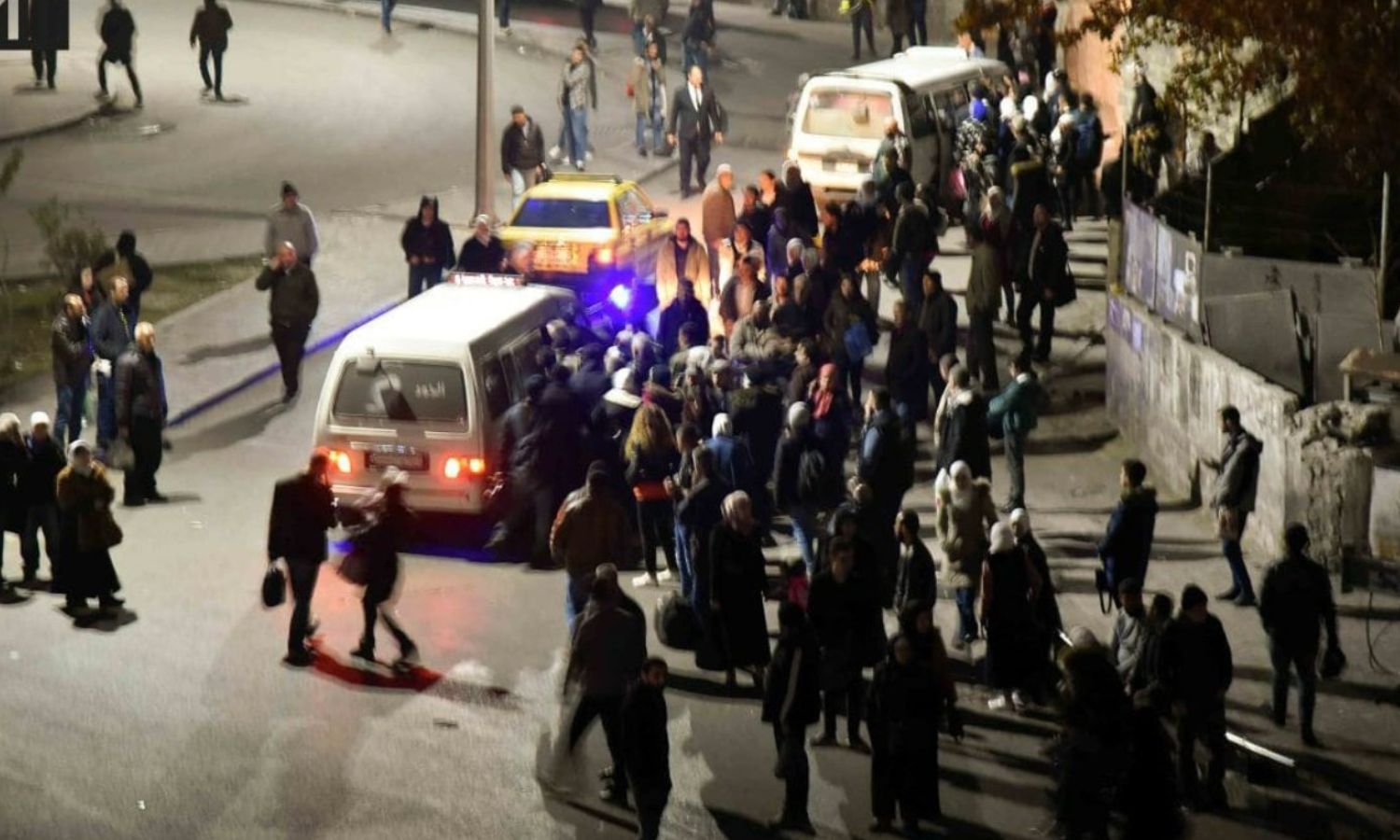
A transportation crisis in Damascus following the recent fuel crisis – 8 December 2022 (Tishreen newspaper)
Iran’s oil supplies were not interrupted by sea through the Syrian ports or by land through Iraqi territory, and they arrived periodically and in unstable or specific quantities, in conjunction with Iran’s support for the regime militarily and politically.
Iran is considered one of the most prominent oil-exporting countries in the world, and it has the third-largest proven oil reserves in the world. Over the past years, it has been included in the list of the top ten countries that export oil in record numbers.
Despite the fuel crisis, Iranian oil supplies to Syria decreased, and shipments estimated at 3.6 million barrels of oil arrived from Iran to the Syrian port of Baniyas last September and 3.5 million barrels in October that followed.
While an estimated 1.39 million barrels arrived last November, according to data from the UANI organization, which specializes in tracking the movement of Iranian tankers via satellite.
According to Iranian sources who spoke to the local al-Watan newspaper, which is close to the regime, on 10 November, Iran promised to raise the quantities of crude oil supplied to the Syrian regime according to the Iranian credit line mechanism from two to three million barrels per month.
The sources stated that the Iranian President, Ebrahim Raisi, took the decision to help the regime overcome the energy crisis.
According to the report, there are promises to activate the decision to increase the quantities of Iranian oil during the “next few period” that have not been confirmed by the regime’s government officials, and its arrival has not yet been announced amid the regime-held areas’ need for six million barrels per month.
Mustafa al-Nuaimi, a researcher in Iranian affairs, told Enab Baladi that the main reason for the failure of more Iranian supplies to reach Syria is the tightening of US control over land oil transport lines coming from Iraq.
In addition to monitoring oil tankers coming from Iran towards the Arabian Sea to the Syrian coast, the reason for this is that the Iranian regime used the cover of exporting oil to pass weapons and ammunition, especially the engines of “precision missiles.”
Al-Nuaimi explained that the reason is also related to the inability of the Syrian regime to pay the value of oil shipments coming from Tehran, pointing out that the Iranian regime is now threatened by its internal and external crises, and it has priorities, and it is no longer able to support the Assad regime in Syria in an unlimited way, so it resorts to a direct request to pay the value of those shipments.
He added that the Syrian regime has become helpless as a result of the sanctions and the US blockade of its project of the illegal drug trade.
The expert on Iranian affairs added that the current internal protests in Iran (after the killing of Mahsa Amini) play a major role in the weak supply of oil to Syria, in addition to previous protests against the deterioration of living conditions and the collapse of the value of the Iranian currency, which raised slogans rejecting continued support for the regime in Tehran to his allies and arms in Syria and Lebanon.
Political economy researcher Joseph Daher said that Syria today depends on oil imports, especially from Iran, so as soon as import problems occur, there will be a crisis in the country, and likewise, the country is directly affected by fuel inflation because the vast majority of these products are imported, and sanctions contribute to import problems, and government policies and “corruption” deepen the problems of access to fuel in Syria.
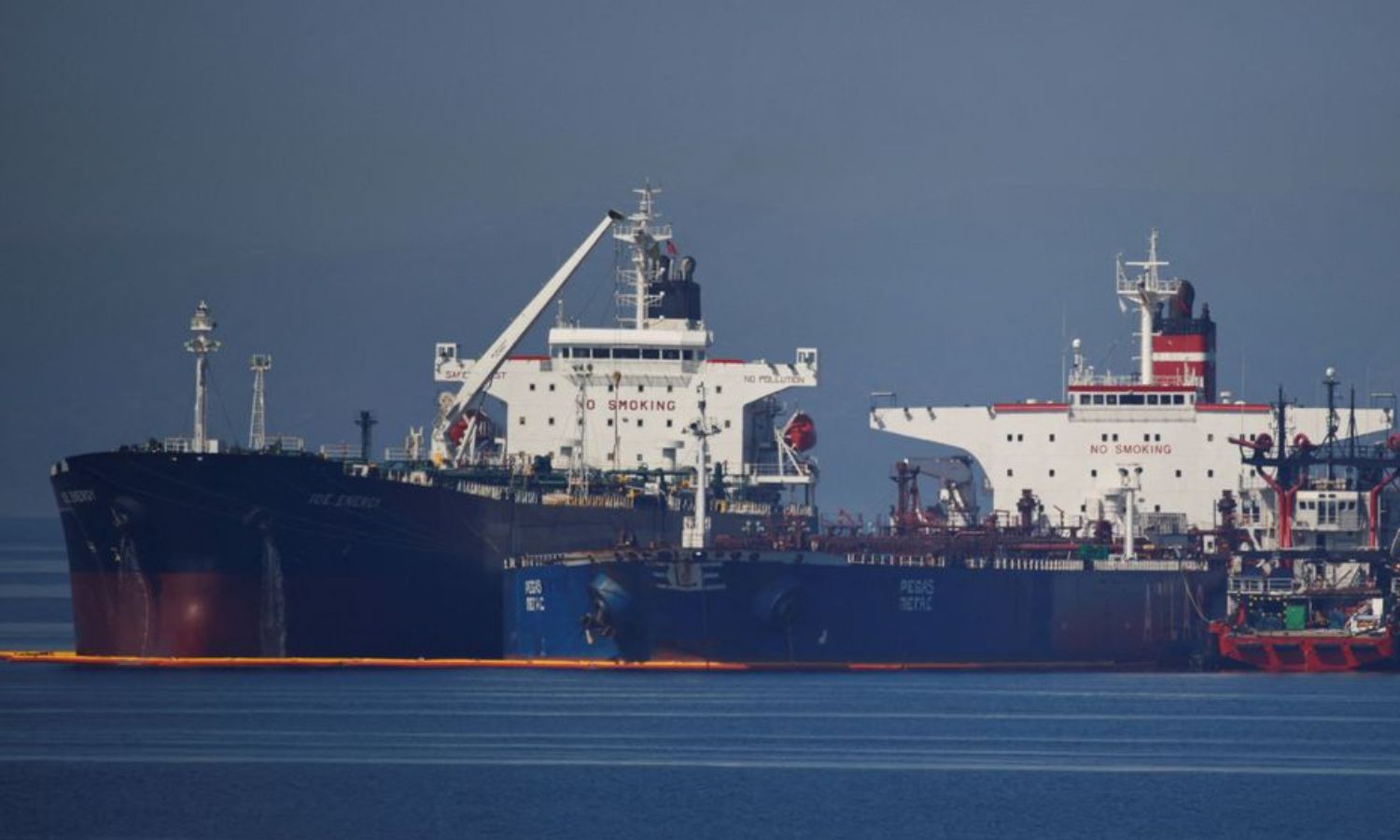
The Liberian-flagged Ice Energy oil tanker transports crude oil from the Iranian-flagged oil tanker Lana (formerly Pegas) off Karystos Beach in Greece – 26 May 2022 (Reuters)
Russia did not appear as an influential actor in the current fuel crisis and what preceded it, although Russia played the largest role in floating al-Assad politically and trying to rehabilitate him at the regional, international, and military levels by changing the course of the battles and rearranging the map on the basis of the dominant powers.
Dr. Sinan Hatahet, senior researcher at the Omran Center for Strategic Studies and co-researcher in the project “Wartime and Post-Conflict in Syria” at the European University Institute, believes that the reason for Russia’s lack of fuel support for the regime is purely economic, pointing out that Russia has not supplied the regime with gas and oil, even in prosperity time.
Hatahet told Enab Baladi that Moscow does not depend on selling liquefied gas to markets outside the pipeline network that connects it to Europe and outside the immediate geographical proximity, Syria is not within this range, and Russia will not connect it to a pipeline network in the future.
With regard to refined oil derivatives, the matter shares the same logistical complexities, as the Russian ports located on the Black Sea, despite their proximity, are “not prepared” for the map of this trade.
On the other hand, the oil that comes out of the Black Sea ports goes to customers who pay cash because the Russian economy is rentier and derives the bulk of its revenues from its internal resources, according to Hatahet.
For Russia, cash payment means continuity and the allocation of public budgets, as it suffered from sanctions even before the Russian invasion of Ukraine, which has been going on since 24 February, so obtaining liquidity is one of its most important priorities since its “illegitimate” seizure of the Ukrainian Crimea in 2014, the researcher adds.
Regarding Russia and Iran being the most important allies of the regime and Tehran providing it with supplies, unlike Moscow, Hatahet believes that Syria cannot secure cash liquidity for Russia, and although the support provided by Iran is also unpaid, it is funded by the line of credit between the two regimes, which is renewed at the value of a billion dollars.
Iran also finds it difficult to market its oil, and it does not have the same infrastructure as Russia, in addition to its traditional customers dealing with other markets, in order to avoid sanctions.
On the other side, the Gulf countries are competing with Iran in attracting major customers such as China and India, which reduces Iran’s export options, and thus supports the regime with fuel from its surplus through the credit line through which it obtains concessions, says Hatahet.
Karam Shaar, economist and director of the Syrian program at the Observatory of Political and Economic Networks, told Enab Baladi that Russia’s aid to the regime was much more conditional than Iranian aid and less generous.
While most of the economic support the regime has received since 2011 was from Iran, the Russian support came in the form of political first, then military, according to Dr. Shaar.
According to Shaar, Russia’s main problem is that the regime’s government is unable to pay the costs required for imports, even though Russia has a surplus of fuel, as a result of the sanctions during its war on Ukraine.
While Iran also has a surplus of hydrocarbons, the terms of its sale to the regime are more generous, in addition to its lower price than the global price after the sanctions imposed on it in 2018, which the regime considered attractive, al-Shaar adds.
Importing oil from Iran was through a loan, and al-Shaar does not see the possibility of loans from Russia to Syria in this regard, with the exception of aviation fuel that comes from Russia.
|
High expenses prevent small industrialists from completing their activities at their normal rate. Even small enterprises that resorted to generators to compensate for the long hours of “rationing” electricity will be affected by the consequences of the crisis. Dr. Joseph Daher, Expert in political economy |
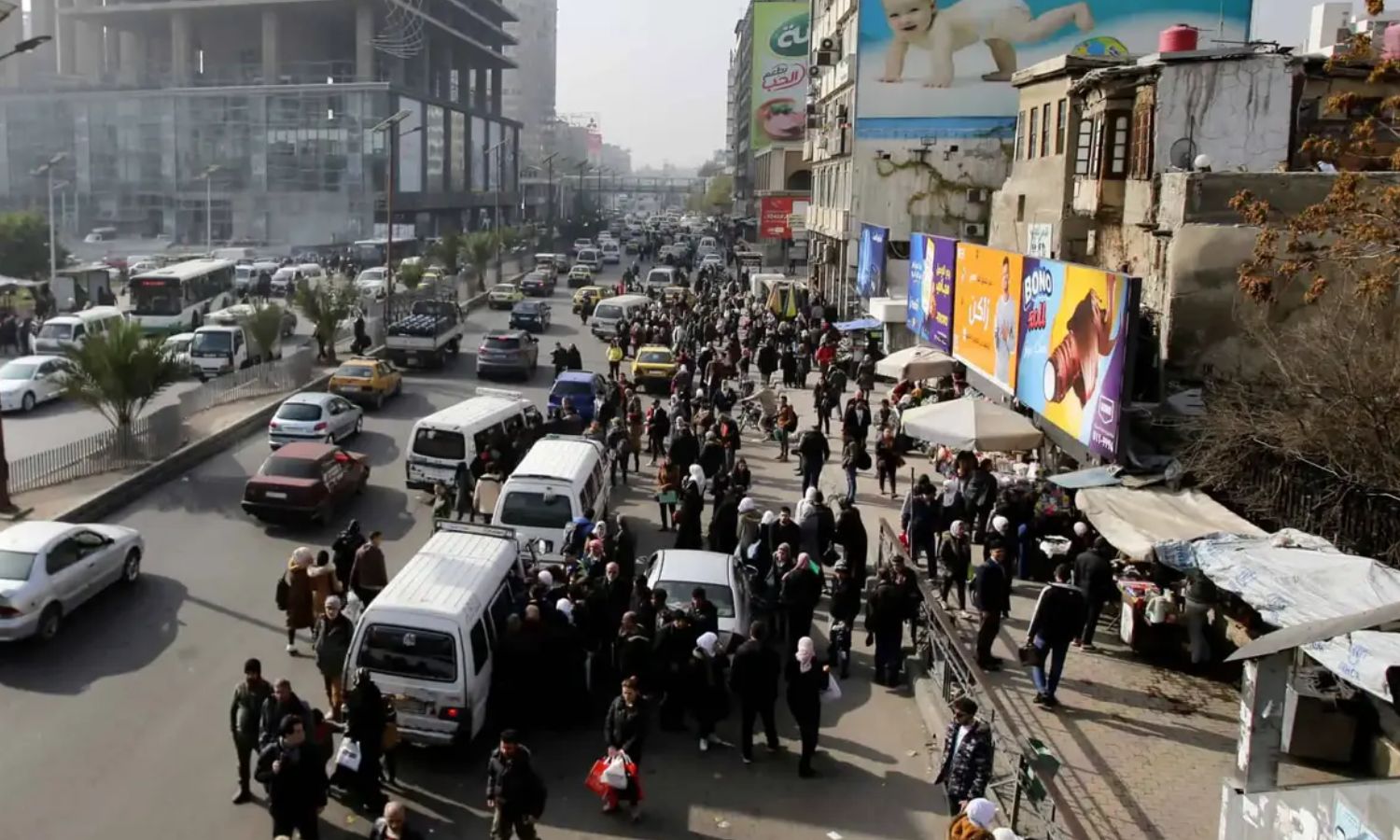
Dozens of people crowd to get a seat inside a transport vehicle during a transportation crisis in a street in Damascus – 13 December 2022 (AFP)
There is no sign on the horizon of an end to the crisis that has been going on for two months, amid “unclear” government promises to address the crisis and the decline in the arrival of Iranian supplies, which disrupted life in regime-controlled areas and disrupted many sectors.
Political economy researcher Joseph Daher believes that the rise in fuel prices negatively affects many sectors, agricultural and industrial projects, and raises production costs, which increases the cost of goods and, thus, the cost of living.
High expenses prevent small industrialists from completing their activities at their normal rate. Even small enterprises that resorted to generators to compensate for the long hours of “rationing” electricity will be affected by the consequences of the crisis, according to Daher.
The academic considered that all these problems are deepening now with the existence of a previous structural problem, and therefore there are no short-term solutions to solve the problem of lack of petroleum products in the market.
Dr. Shaar believes that what has been happening recently is a state of restlessness among the Iranians and the Russians, and this is due to the inflexibility of the Assad regime with regard to a political solution, and although the two countries consider the regime an ally, they are not ready to “support it forever,” without any horizon for solutions indicating that they will eventually benefit from their intervention in Syria.
Shaar considered that what obstructs this matter is the political solution and that the two allies are aware that al-Assad is the cause of this obstruction.
It has recently appeared that the Iranians are not willing to send fuel to the regime through loans but rather in cash, according to Shaar.
|
The Syrian regime will remain largely dependent on gas and oil imports from foreign markets; however, the difficulties represented by some countries refusing the sale of oil to the regime, coupled with the loss of liquidity, especially in foreign exchange, are highly likely to prolong the crisis. Dr. Sinan Hatahet, Senior researcher at the Omran Center for Strategic Studies and Sharq Forum |
Hatahet sees no way out of the fuel crisis in the near future since the domestic production does not cover the market’s needs, and even in the event of any agreement with the SDF, the current production in the eastern Euphrates regions does not meet the need.
The researcher mentioned that in the past, the regime was financing part of the import process through foreign currency in Lebanon, but Lebanon’s financial crisis made solutions “almost non-existent.”
Journalist and business expert Adnan Abdul-Razzaq believes that the situation will worsen the longer it lasts and that prolonging the Syrian conflict is the only international decision agreed upon today, in addition, that the continued scarcity of oil in the domestic market will raise the prices of consumer products, thus increasing poverty and destitution, and will severely affect industry and trade.
if you think the article contain wrong information or you have additional details Send Correction